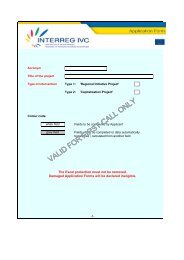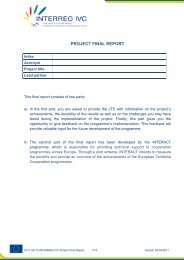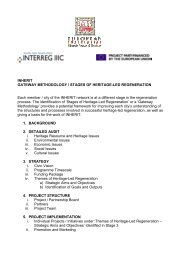Promotional brochure about the Region
Promotional brochure about the Region
Promotional brochure about the Region
You also want an ePaper? Increase the reach of your titles
YUMPU automatically turns print PDFs into web optimized ePapers that Google loves.
<strong>Region</strong>al policiesF. BOCQUETPhotomontage of Louvre-LensE. WATTEAUEDUCATION AND TRAININGThe <strong>Region</strong> spends 23% of its budget on highschools and training, which are its main responsibilities,27% on lifelong learning and 9% onapprenticeship. In 2005 and 2006, following <strong>the</strong>decentralisation of competencies, <strong>the</strong> <strong>Region</strong>took responsibility for health and social trainingand <strong>the</strong> management of customer service andmaintenance staff in high schools. With 153,000high school students and 17,000 apprentices, <strong>the</strong><strong>Region</strong> is innovating to create <strong>the</strong> best possibleteaching conditions and to open up access totraining.TRANSPORTThe <strong>Region</strong> supervises <strong>the</strong> regional rail networkand <strong>the</strong> “TER” (<strong>Region</strong>al Express Rail Network)alongside French Railways. 24% of <strong>the</strong> regionalbudget is spent in this area. By buying newtrains, redeveloping stations, setting specificfares and increasing by 60% <strong>the</strong> number oftrains on <strong>the</strong> network, <strong>the</strong> <strong>Region</strong> is investing in<strong>the</strong> development of <strong>the</strong> regional express train inorder to increase people's mobility by means ofa modern transport system which provides analternative to car.SPATIAL PLANNINGAND REGIONAL PLANNINGThe future of <strong>the</strong> Nord-Pas de Calais depends on<strong>the</strong> ambitious and harmonious development of <strong>the</strong>whole region. The new regional town and countryplanning and development scheme set out <strong>the</strong>guiding principles for action by 2020: promotingregional public interest, developing public services,modernising regional public action and enforcingsustainable development. The regional policy featuresmajor projects: <strong>the</strong> opening of a new branchof <strong>the</strong> Louvre museum at Lens, <strong>the</strong> roll-out of <strong>the</strong>regional express train and <strong>the</strong> completion of <strong>the</strong>railway tests for <strong>the</strong> "i-Trans" global competitivenessclusters.ECONOMIC DEVELOPMENTThe ambition of <strong>the</strong> Nord-Pas de Calais region is tobecome a major European economic region. The<strong>Region</strong> has set itself <strong>the</strong> following priorities: supporting<strong>the</strong> creation and development of economicactivities, structuring <strong>the</strong> region around centers ofeconomic excellence, prioritising innovation and<strong>the</strong> promotion of basic research, fostering foresightrethinking its international economic commitments,mobilising and coordinating financial tools,making broadband Internet universally available,supporting local development and consolidatingsolidarity with employees affected by restructuring.F. LO PRESTIP. MORES
B. GROSSMANN F. LO PRESTIAGRICULTURE AND FISHERIESThe <strong>Region</strong> provides its support to two leading sectorsin <strong>the</strong> Nord-Pas de Calais: agriculture andfisheries. When it comes to agriculture, action istaken in <strong>the</strong> field of farming maintenance and developmentprogramme by promoting agriculturaldiversity while respecting <strong>the</strong> environment, andconsolidating its position in regional markets andmarkets throughout Nor<strong>the</strong>rn Europe in <strong>the</strong> contextof Common Agricultural Policy reform. As far asfisheries are concerned, <strong>the</strong> <strong>Region</strong> undertakes farreachingactions such as support to <strong>the</strong> modernisationof boats and promotion of regional resources.RESEARCHThe <strong>Region</strong> has contributed to <strong>the</strong> creation and developmentof laboratories in <strong>the</strong> Nord-Pas de Calais, andto <strong>the</strong> emergence of regional research centres ofnational standing by bringing toge<strong>the</strong>r university,laboratory and industrial figures in <strong>the</strong> framework ofstructured projects in state-of-<strong>the</strong>-art sectors. The<strong>Region</strong> currently consolidates <strong>the</strong>se centres of competitivenessand excellence, including <strong>the</strong> "i-Trans"cluster. It ensures that its researchers are mobile, byproviding assistance and contributing to technologytransfer and supporting innovation by creating newcentres and platforms.D. BOKALO / RÉGION NORD-PAS DE CALAISRÉGION NORD-PAS DE CALAISNEW TECHNOLOGIESSince <strong>the</strong> 1990s, <strong>the</strong> <strong>Region</strong> has been workingtowards an interdependent information society. It isa pioneer in <strong>the</strong> area since it has created 175 cybercenters to introduce local people to new technologies.It works to provide broadband access throughout<strong>the</strong> region, supporting teaching initiativeswhich make use of <strong>the</strong> potential of new technologiesand building network use in research andhigher education, health and culture.HEALTHHealth indicators are still a source of concern in <strong>the</strong>Nord-Pas de Calais, and <strong>the</strong> <strong>Region</strong> works to improvepublic health in <strong>the</strong> region. It takes part on threeactions: <strong>the</strong> fight against cancer, health and <strong>the</strong>environment, and supply of and access to healthcare.The <strong>Region</strong> thus demonstrates its desire to innovatein order to implement an effective public healthpolicy able to unite all involved actors.
2008<strong>Region</strong>al Budget<strong>Region</strong>al Programmes1.9 billion Euros, withP. DUPUICHENVIRONMENTThe <strong>Region</strong> is today a recognised partner in environmentalmatters, in fields such as <strong>the</strong> preservationand promotion of bio diversity, environmentalquality, energy management and waste recycling.The region still bears <strong>the</strong> scars of its industrial heritageand is committed to regenerate its landscapeand fur<strong>the</strong>r to demonstrate itself as a pioneer in <strong>the</strong>quest for real and shared sustainable development.CULTUREThe Nord-Pas de Calais is <strong>the</strong> top French regionalinvestor in culture. It boasts an exceptional culturalheritage: <strong>the</strong> biggest museum network in France,soon to be streng<strong>the</strong>ned by <strong>the</strong> branch of <strong>the</strong>Louvre in Lens, numerous facilities, includingsome of international renown, such as <strong>the</strong> LilleNational Orchestra and a vibrant artistic creationprocess supported by <strong>the</strong> <strong>Region</strong>. The <strong>Region</strong> alsohosts major cultural events. Beside Lille2004European capital of culture programme, <strong>the</strong> <strong>Region</strong>created "Cultural Belfries" in <strong>the</strong> framework of"Around Lille2004", and <strong>the</strong>n "<strong>Region</strong>al capital ofculture", an event which has been launched in 2007and will be held every two years.Revenues86 M€Culture85 M€Apprenticeship227 M€Professionnel Training282 M€Education25%Tax levy4%O<strong>the</strong>r revenues36%State subsidies371 M€Infrastructures-Transport22%Loans13%Motor fuel tax2007-2013Nord-Pas de CalaisEuropean FundingOP competitivenessE. WATTEAUERDF : € 700 MESF : € 380 MEAFRD : € 46 M
Main European infrastructures around Nord-Pas de Calais <strong>Region</strong>Gare TGVSeptem bre 2007
The Nord-Pas de Calais,a region of diversityA TEXTILE REGION• The 2nd biggest technical textileregion in France, with nearly 200companies and 9,000 jobs• A competitiveness centre: <strong>the</strong> Up-Tex(innovative textiles) cluster, whichdevelops high-performance textilesfor <strong>the</strong> future, used in transport, <strong>the</strong>automobile industry, medicine andhealth, industry, sports and leisure, protection and public civilengineering.• A breeding ground for innovative business entrepreneurs:Innotex, <strong>the</strong> company behind Maisons de mode, in-townworkshop boutiques which work with young fashion stylists.• An "embroidery and lace" network, a centre of excellence in<strong>the</strong> areas around Cambrai and Calais, with a top-of-<strong>the</strong>rangespecialization.M. SPINGLERJ. BERQUEZA REGION OF ECO-INNOVATION• The Nord-Pas de Calais, a region boasting 450 ecobusinessesspecialising in soil treatment.• A creation and development centre for eco-businesses:C2DE.• The 1st French region to establish a resource centrefor sustainable development (CERDD).• A region in which numerous local initiatives aremaking real progress in sustainable development: aselective household waste recycling plant in Triselec; awaste recycling, reuse and regeneration plant inHalluin; <strong>the</strong> water-borne transport of household wastein Lille; a sustainable development initiative in <strong>the</strong>town of Loos-en-Gohelle• An active support given to regional actions in <strong>the</strong> areaof energy management.• The creation of a professional solar energy network.A REGION WITHA STRONG RAILWAY NETWORK• A region which has doubled <strong>the</strong> number of regional express trainson it’s network in 30 years.• The region of Thalys, Eurostar and TGV.• The region of <strong>Region</strong>al High-Speed Trains, placing all <strong>the</strong> bigtowns in <strong>the</strong> region at less than an hour from <strong>the</strong> regional capital.• France's leading railways industry, with 30% of national activityand 3 world-leading companies in <strong>the</strong> Valenciennes area.• A sector structured around "i-Trans, Railways at <strong>the</strong> heart ofInnovative Transport Systems", a competitiveness centre with aglobal outlook.A. ROBINA REGION OFHEALTH PR• A strong policy opromotion, in <strong>the</strong>areas of excess mtation of health p• A programme cfight against canvement of patiefinancing of hehealth (risk analment of supply a• A flagship regioPasteur Institu(Eurohealth) cenuniversity hospitpanies and 2000P. MORESAN AGRO-FOODBUSINESS REGION• The 4th biggest region in France by number of employees: 28,000.• 300 companies with more than 20 employees.• The 2nd biggest French region in agrofoodexports.• Highly diverse food production: chicory,endives, etc.• 2 centers of agro-industrial competitiveness:<strong>the</strong> fisheries competitivenesscluster in Boulogne-sur-Mer, a leader in<strong>the</strong> seafood sector; <strong>the</strong> Nutrition, Healthand Longevity competitiveness cluster,which brings toge<strong>the</strong>r world industryleaders and biological health researchers.A LOGISTICSAND DISTRIBUTION REGION• The leading European region for disEuropean concentration of leading comand <strong>the</strong> European distance selling exhib• Nearly 40 distribution companies heascale.• A competitiveness center: distribution m• A strategic location at <strong>the</strong> heart of EuCCI BCO
EVENTIONf health prevention, education andface of worrying statistics in <strong>the</strong>ortality, cancer and late consulrofessionals.entred around three plans: <strong>the</strong>cer (prevention, screening, improntcare, research support andavy equipment); environmentallyses); and health care (improvenddistribution).n for biological health, with <strong>the</strong>te in Lille, <strong>the</strong> Eurosantétre based on Europe's biggestal site, and more than 6000 comresearchersactive in <strong>the</strong> sector.tance selling, with <strong>the</strong> highestpanies and more than 200 firms,ition.dquarters of national and worldNFXD. BOKALO / RÉGION NORD-PAS DE CALAISA REGION OF MOBILITY• A region at 38 minutes from Brussels by TGV, 1 hourfrom Paris and 90 minutes from London.• A region developing high quality short and long-staytourism, with 38.4 million overnight stays in 2006.• A region which has provided a practical and accessible<strong>Region</strong>al Express Train network to its residents, fullyintegrated with o<strong>the</strong>r inter-urban andurban public transport systems.• The region home to <strong>the</strong> world's firstentirely automatic metro, <strong>the</strong> VAL inLille.• A region which encourages its studentsto study abroad, through itsBlériot international mobilitygrants.• A region which also makes provisionsfor foreign researchers towork in its universities and hascreated 3 international chairs towelcome renowned researchersinto its regional laboratories.A REGION OF ECONOMIC RECONVERSIONAND OF BUSINESS CREATION• 12.848 new business creations in 2007.• The result of a unique system in France, bringing toge<strong>the</strong>r regionmental and partnership initiatives: a regional programme of trainifor entrepreneurs; a campaign fostering business creation and thof a regional information web site: www.jecree.fr ; managementand business hives, etc.• The leading French region for foreign business investment, with anpromotion agency, NFX, linking up local facilities such as DPromotion and APIM in Lille.• The creation in <strong>the</strong> 1980s of powerful conversion tools such asBasin Investment Fund (FIBM) and Finorpa.A REGIONOF SOLIDARITY• A region which spends 1% of each policybudget on North/South cooperation.• A programme of actions centred on economic development, educationand health in Mali, Senegal, Morocco, central Vietnam and Madagascar.• A region committed since 1991 to cooperation agreements with <strong>the</strong>Silesian Voivodeship in Poland, <strong>the</strong> original home of much of its Polishcommunity.• Support for interdependent projects based in countries around <strong>the</strong> worldusing <strong>the</strong> creation of a special designed financial tool, <strong>the</strong> regional aidfund for projects of cooperation and solidarity (SISA).• The creation of a fund for local residents in <strong>the</strong> region to participate in <strong>the</strong>financings of micro-projects in <strong>the</strong>ir neighbourhoods, or linked projects.P. FRUTIERanagement.rope, ideal for high-performancelogistics: main road and railaxes, Lesquin airport, Lilleriver port and Calais andDunkerque commercial ports.• A recently built multimodalplatform - Delta 3 -equipped with a combinedrail/road/river transportterminal.P. DUPUICHC. BLANQUART
al, departngsupporte openingboutiqueseconomicDunkerque<strong>the</strong> MiningA YOUNG REGIOND. BOUFILJA• The youngest Frenchregion, with 1.48 millionunder 25-year-olds.• 200 state secondaryschools and 74 private schools, 153,000 high school students,• 17,000 apprentices.• 7 universities, 25 specialised “grandes écoles” and 150,000 students.• A region which is a veritable breeding ground for high-level sportspeople, with football training centres (Lille, Lens -Liévin and Valenciennes) linked to <strong>the</strong> big regionalclubs: LOSC Lille, RC Lens and Valenciennes FC.• Two international-level athletics venues: <strong>the</strong>Stadium Nord at Villeneuve d’Ascq and <strong>the</strong> regionalindoor stadium at Liévin.A REGION OF SUSTAINABLEDEVELOPMENT• A region heavily marked by its industrial past and committedfrom an early date to <strong>the</strong> regeneration of itslandscape: <strong>the</strong> first regional national park was createdin 1968, <strong>the</strong> "Industrial wasteland" policy was launchedin 1982, <strong>the</strong> Public land institution (EPF) was created in1990, <strong>the</strong> wind power network was set up in 1993, <strong>the</strong>polluted sites and soils skills centre was established in1995, and so on.• The first French <strong>Region</strong> to be given Agenda 21 status(a sustainable development project), followed by adevelopment and support policy for local Agenda 21projects.• Exemplary regional actions in <strong>the</strong> field of sustainabledevelopment: High Environmental Quality constructions,<strong>the</strong> green and blue natural corridors (a programmefor organic connections between ecosystemsfor <strong>the</strong> preservation of regional bio diversity),support for fair trade, etc.J.P. JOHANNESA MARITIME REGION• 90 miles of coastline and <strong>the</strong> busiest stra• An exceptional natural space featuringNez (White Nose) capes: <strong>the</strong> Parc nad'Opale.• A major port system: Dunkerque, an inFrench commercial port; Calais, Europecross-channel tunnel departure point angest fishing port and Europe's leading ceand commercialisation of seafood produAN AGRICULTURAL REGION• The biggest French regional producer of potatoes,endives, chicory, peas, chrysan<strong>the</strong>mums and driedbeans.• The 4th biggest French regional producer of wheat.• 28,000 workers.• 853,000 farmed hectares, and 2/3 of <strong>the</strong> region's landarea.• A tradition of market gardening around Saint Omer.• A region full of large, green open spaces, with littlewoodland (less than 8% of <strong>the</strong> land area), including3 regional parks (Avesnois, Côte et Marais d’Opaleand Scarpe Escaut).A PARTNERSHIP REGION• A partnership culture which has fostered <strong>the</strong> emergence of innovative and ambitiousregional projects, in a tradition marked by friendly societies and cooperatives;- territorial contracts bringing toge<strong>the</strong>r local authorities, <strong>the</strong> <strong>Region</strong>, <strong>the</strong> State and<strong>the</strong> Europe to work toge<strong>the</strong>r to achieve development objectives;- <strong>the</strong> "Cultural Belfries" programme, encouraging cooperation between nationaland small local museums in order to put on major exhibitions in town halls;- public/private cultural partnerships: funding for “Lille2004”, European capital ofculture, sponsorship for regional facilities frombusiness associations, such as"Regards et Entreprises" for <strong>the</strong>Modern Art museum at Villeneuved’Ascq, Arpège for <strong>the</strong> LilleNational Orchestra, etc.;- <strong>the</strong> creation of <strong>the</strong> BMU2005association to obtain Unescoworld heritage status for <strong>the</strong>Nord – Pas de Calais Coal Miningbasin.V. VANBERKEL
CUDLit in <strong>the</strong> North Sea and <strong>the</strong> Channel.<strong>the</strong> Gris Nez (Grey Nose) and Blancturel régional des Caps et maraisdustrial port and <strong>the</strong> third biggest's number one passenger port andnd Boulogne-sur-Mer, France's bigntrefor <strong>the</strong> processing, distributionce thanks to its fisheries cluster.A BORDER REGION• 220 miles of shared borders withBelgium.• A continuous cross-border Franco-Belgian metropolis of 1.7 million inhabitants(Lille-Courtrai-Tournai);• Daily population transfers enabled by<strong>the</strong> cross-border bus and RET links;• A for<strong>the</strong>coming Eurodistrict aimed atreducing <strong>the</strong> border effect and encouragingcross-border transport cooperation,<strong>the</strong> green and blue corridor,water resource management, and soon;• A major import/export region whoseborders are crossed by significantNorth-South traffic, particularly fromRotterdam and Antwerp, and whichhas developed highly competitive customsprocedures.AN INDUSTRIAL REGION• The 3rd biggest French industrial region, with more than263,000 workers and 13,500 companies.• 19% of <strong>the</strong> regional active population works in industry, and66% in <strong>the</strong> tertiary sector.• The 2nd biggest French car-producing region, with 4 manufacturersand an extremely dense network of equipmentmanufacturers and sub-contractors, providing a total of55,000 jobs.• France's leading region for metallurgy and metal processing,with 37,500 employees.• A world leader in household and industrial glassware, with25% of <strong>the</strong> national workforce.F. LO PRESTID. BOKALO / RÉGION NORD-PAS DE CALAISA MULTICULTURAL REGION• A historic regional melting pot, as its architectural andmilitary heritage bears witness to.• A region where populations have long inter-mingled,with successive waves of immigration satisfying industrialneeds from Belgium, Italy, Poland and North Africa,from 1910 to <strong>the</strong> 1970s.• An innovative region, transforming industrial and publicbuildings into cultural sites: Culture Commune companyin <strong>the</strong> mining basin, “La Piscine” museum in Roubaix,<strong>the</strong> Calais Channel, <strong>the</strong> FRESNOY National Studio ofContemporary Arts in Tourcoing, and so on.• A region of cultural events, such as Lille2004, Europeancapital of culture, and Bombaysers de Lille 3000, anevent with an international focus.AN URBAN REGION• The 3rd most populous French region, with4 million people and a density of 322 inhabitantsper km 2 , in line with <strong>the</strong> Nor<strong>the</strong>rnEuropean average.• 4 Nord-Pas de Calais residents out of 5 livein urban areas.• A regional capital city of 1.4 million Frenchinhabitants clustered around <strong>the</strong> LilleUrban Community and 8 urban areas ofmore than 100,000 inhabitants.• 35 years of proven urban regenerationknow-how: <strong>the</strong> creation of <strong>the</strong> new town ofVilleneuve d’Ascq, and <strong>the</strong> expertise andexperience combined in <strong>the</strong> renewal/regenerationof Roubaix.D. BOKALO / RÉGION NORD-PAS DE CALAIS







